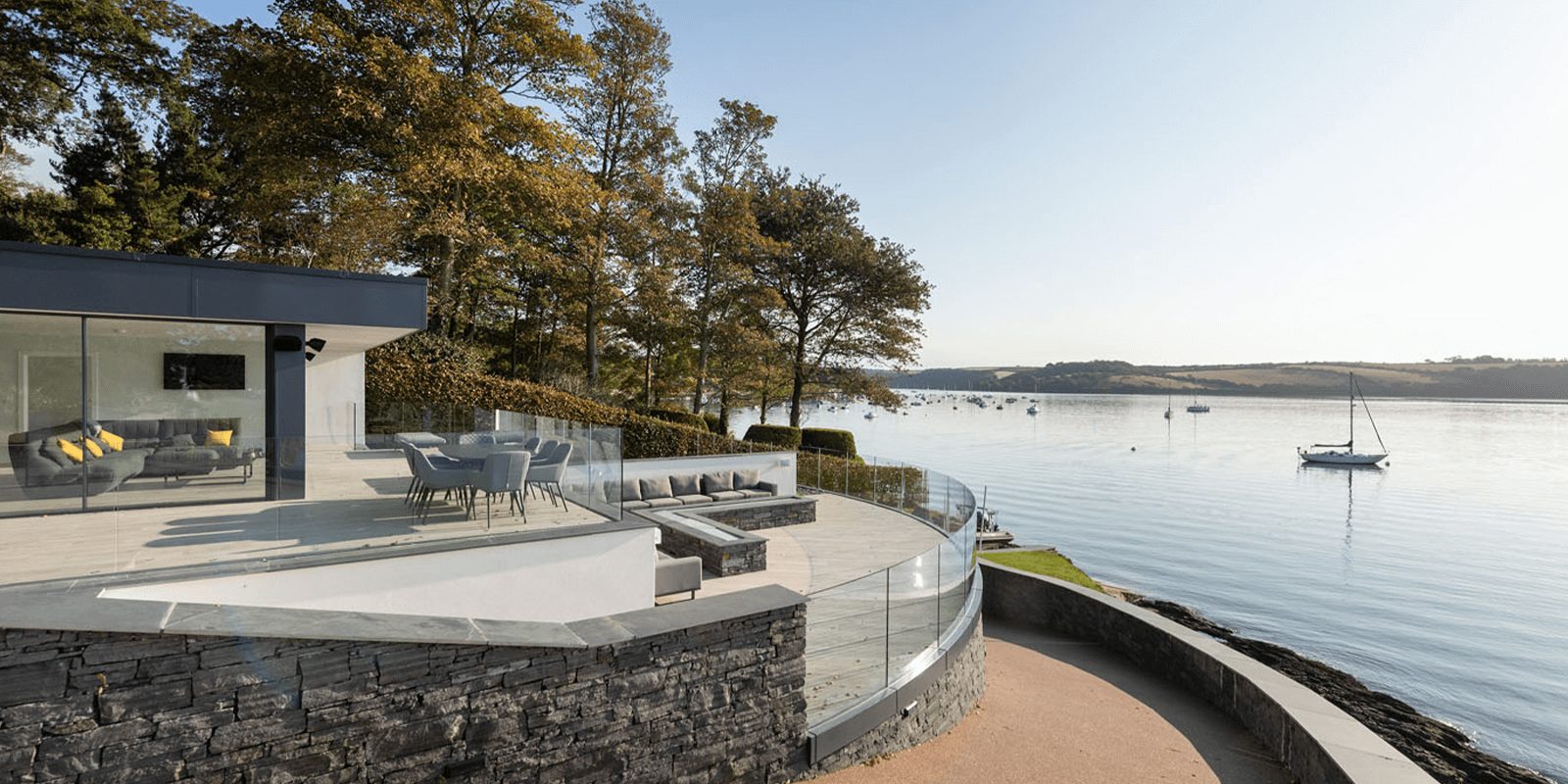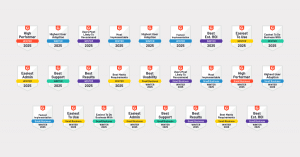Laurence Associates are an award-winning, multidisciplinary practice. With a team of in-house chartered planners, architects, designers and landscape architects who work collaboratively, the planning-led practice is able to offer bespoke, fully integrated development solutions. In short, they’re excellent in myriad ways — and their business and project management systems need to support them in each and every way they excel. Which is a complex, but beautiful built environment thing.
Laurence Associates’ effervescent business manager, Katherine Shannon, took the time to chat with us during lock-down about how Synergy software gives them “Clarity — for management, fee earners and, most importantly, for clients” and how that’s giving them more time for their incredible design.
A multidisciplinary built environment design practice
Founded in 1993, Laurence Associates began as a practice of one town planner, but when design director Jason Pledger joined the team around the same time as the now managing director, Richard Marsden, Jason spearheaded the development of the design arm of the business — having realized the valuable scope for providing clients with a much more efficient approach by allowing and providing the design elements of developments within the one practice.
“It goes hand in hand really, and it’s much more efficient to have it all in-house,” says Katherine, “Architects that work for us who’d previously come from pure architecture, really like the fact that you’ve got that planning advice on hand while they’re designing, because it feeds into, and often informs the design process. Especially if you’re pushing the boundaries from a planning perspective — they can literally walk across the room and ask a question, or, now that we’re remote, ping a question.
“And it works both ways as well. Once something’s in planning, if the case officer doesn’t like something, wants it tweaked, it can be done very quickly because they’re all on hand to do it — as opposed to having to contact a separate practice and getting them to feed it into their workflow. It’s all there and it’s very instant. And we’re all obviously using Synergy. We’re all using one project and practice management system.”
Saving emails to projects — genius
Katherine explains that, in the dark ol’ days before Synergy, the practice used to expend tens of hours per week of technical assistant time, just to save emails. You can’t have a fee-earner doing that unbillable admin, it’s true. But it’s also a waste of a good tech assist’s time.
“It’s genius to have the ability to save email at the click of a button. We literally used to have our technical assistant spend hours a week to take the burden off the fee-earners so that they could progress with their work for the client — because the client doesn’t want to be told that their project wasn’t progressed because the fee-earner was saving emails, do they?
“So, we used to give that to our technical assistant, and it would take her hours and hours saving emails and that was so tedious — necessary, but tedious. Now we don’t have to do that, and she’s freed up to do other things. It’s been brilliant. Obviously, the time that saved in itself has been fantastic.”
Life before Synergy
Laurence Associates began rolling out Synergy in mid 2019. But before that, their business and project management comprised disparate spreadsheets, a separate project management software system, and a stand-alone timesheet software. Not exactly the dynamism and seamlessness of the work being produced in the rest of the practice.
“We had Excel spreadsheets,” says Katherine, “we had a different project management system, and we used to use a timesheet system because we did realize a couple of years prior that writing down time on timesheets is not accurate. The timesheet software was very straightforward if you were just putting time against a project at your rate, however, being multidisciplinary we needed more detail.
“We had different rates of fee-earners doing different things, on different phases, and different stages of various projects. So, we ended up with multiple projects on this system in order to help the fee-earners have some clarity about what their budgets were — because it was very, very difficult, as they would get a lump of hours allocated to a project — it just wasn’t clear enough for them to work out how much time they had for different stages.”
Flexible security access allows managers to take ownership of their projects
Katherine says that Synergy solves those issues. “because you can allocate all the budgets and the time within the different phases and stages. And it’s clear — it translates through in the documents, to the fee proposal. We’ve given the project managers and fee-earners enough security access to be able to see and take ownership of their projects.
“They’re all highly qualified people, and giving them the actual ownership of their projects — the ability to run with them and take more control — it’s liberating for them, I think. It gives them more autonomy and ability to do their best work. It shouldn’t be a secret what the client is paying and what’s expected of them. They do have KPI targets as well, so it’s also about sticking to the project budgets because in order to achieve a good KPI result, they need to be able to say that the time they’ve spent is actually chargeable as well.
“Synergy allows clarity for them. When they look at a project, they can see the financials straight away and see how it’s been sold to the client.”
Clear budgets (and expectations)
“Obviously, we put fee proposals together based on the time we think we’ll spend” says Katherine, “And sometimes we know it’s going to take longer than the budget, but we want to do the job for other reasons. With Synergy, we can put notes on the system so that project owners are aware of that as well. Again, it takes the pressure off the individual fee-earner because they can see what’s expected of them, or not expected.”
This sort of clarity means that if they’ve decided a project has priorities over and above profit, the Laurence Associates team can all remain clear where, when, and how much those margins can be sacrificed.
“You can put notes against a project budget to say, ‘this is the budget; however, we expect that it will go over because we’re hoping to sell the next stage on, which will be more profitable’ or whatever the case may be. In our industry there’s always going to be elements occasionally where you can see a potential long-term relationship with a new client and take a bespoke approach to how you put together fee proposals and set up different projects.”
A collective, cloud-based system answers covid management challenges
Katherine says the whole Laurence Associates team enjoys having Synergy, but that the software platform only increased in value in the face of the covid pandemic and associated lock downs.
“It’s been really good from a management perspective particularly. For fee-earners, they’re using the timesheets and they’re looking at the project budgets and so on, but from a management and administration perspective, it’s meant that we can continue to manage the practice remotely as a group.
“The reporting functions meant that we could really do a deep dive into our sales pipeline. We could contact all of our clients and prospective clients straight away and we could use all the custom fields to allocate them different statuses or tags — so that we knew what was on hold because of covid, what wasn’t on hold, what was done with. As a result, we got this really clear, realistic pipeline, which is really important when you’re looking at staffing levels in a crisis like that.
“It also meant we knew what date we should approach the client again for sales. It really helped in that respect — rather than what we would have had previously, which is a long spreadsheet of information that would just be unwieldy, not necessarily accessible by everybody, and not agile enough to keep current.
“Honestly, the number of times, as a management team, we’ve said, ‘Thank goodness for Synergy — thank goodness for Synergy during covid!’ Because our finance manager, and I, we’re constantly on Synergy, running reports, checking things, tweaking things. We’re in there all day.”
Industry-specific software, built with and for you
The fact that Synergy is built with and for built environment practices is important to Laurence Associates. The continual development of the platform and collaboration with built environment professionals actually using the product mean it has the agility to support customers in just the way they need and want it to.
“We enjoy the fact that we can contact the team in London if something’s not working, or if we start to use something and need assistance — we have a true feedback mechanism, and they are very open to taking it on board and feeding that into the development process. We do feel like we have a voice, which is great. As opposed to it being like Microsoft, for example, where Teams functionality is Teams functionality, whether you like it or not.
We can actually say, ‘We’ve started using this feature — can we ask these questions? Is it possible to do this?’ or, ‘We’ve noticed a bug’, and then it’s reported and looked at. If there’s a reason why it’s that way, then it’s explained. If not, then generally the changes are made. And I get the impression that that happens across the board, that most Synergy customers feedback, because we’re regularly told, ‘Yes, that’s been raised, and it’s being looked at’. Which is great.
Clarity for managers, fee-earners, and clients
For Katherine, the question of ‘why Synergy?’ is quickly and emphatically answered with one word: Clarity! Clarity of data for management, to allow strategic, fact-based decision making. Clarity of project budgets and requirements for fee-earners, allowing them to manage their time efficiently and effectively. And, perhaps most importantly, clarity of invoices for clients, allowing them to see where and when time was spent by fee-earners on their project.
“We’ve actually started giving work breakdowns for all estimated work. We give monthly breakdowns because we find it so much clearer and it reduces the time spent dealing with client queries — which are rarely complaints, but often a matter of them not remembering what they’ve asked for, or losing track as time goes on — whereas if they can actually see what we’ve been doing in the breakdown, it saves everyone time and confusion.
“That’s just an example, and the fee-earners are using it in a much more simplistic manner, but in the management team we’re constantly in Synergy, constantly using it, and it’s just… It’s really quite the godsend.”





